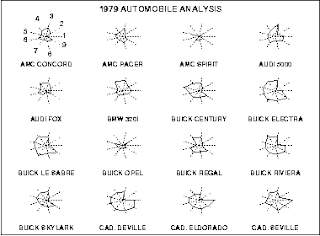
http://www.itl.nist.gov/div898/handbook/eda/section3/gif/starplot.gif














Bilateral Graphs show two different variables. this graph shows the difference in giving humanitarian aid in both percentage amounts and in actual dollar amounts. As you can see, Luxembourg's increase was small in actual dollar amounts but huge in terms of increase, and the United States decrease was large in terms of dollar amounts, but small percentage wise.

 Univariate choropleth maps show a single variable show only one set of data... this being the percentages of the population that voted Republican in the last election, the map goes from 0%, or 100% Democrat, in blue, to 100% Republican in red, with Purple being somewhere in the middle. This map was made my a Princeton professor. http://www.princeton.edu/~rvdb/JAVA/election2004/purple_america_2004_small.gif
Univariate choropleth maps show a single variable show only one set of data... this being the percentages of the population that voted Republican in the last election, the map goes from 0%, or 100% Democrat, in blue, to 100% Republican in red, with Purple being somewhere in the middle. This map was made my a Princeton professor. http://www.princeton.edu/~rvdb/JAVA/election2004/purple_america_2004_small.gif Bivariate choropleth maps use two variables to show data. This map in particular shows the hometowns of Olympic athletes with the blue standing for the Winter Olympics, Red for the Summer, and Purple for the counties that have both. This was found on the Sports Illustrated Website. http://www.directionsmag.com/images/articles/sportsillustrated/Olympic_Athletes.jpg
Bivariate choropleth maps use two variables to show data. This map in particular shows the hometowns of Olympic athletes with the blue standing for the Winter Olympics, Red for the Summer, and Purple for the counties that have both. This was found on the Sports Illustrated Website. http://www.directionsmag.com/images/articles/sportsillustrated/Olympic_Athletes.jpg





 A Digital Elevation model is a map that uses different shades to show the topographic and biological differences between areas. As you can see on this map, the lighter shaded portions show relief and higher elevations while the lower lying green areas indicate vegetation cover. This map of Honolulu has found on a website selling GIS software.
A Digital Elevation model is a map that uses different shades to show the topographic and biological differences between areas. As you can see on this map, the lighter shaded portions show relief and higher elevations while the lower lying green areas indicate vegetation cover. This map of Honolulu has found on a website selling GIS software. DLG is a map which uses vector rather than raster data. It is concidered one of the less technologically advanced mapping types as it self but is useful when overlaying with other maps using GIS technology. This map was found on the USGS website. http://images.google.com/imgres?imgurl=http://erg.usgs.gov/isb/pubs/gis_poster/gisgraphics/figure1a.jpg&imgrefurl=http://erg.usgs.gov/isb/pubs/gis_poster/&h=232&w=300&sz=66&hl=en&start=15&sig2=8RWgp8w5RnqBudUtP6lxEA&um=1&tbnid=9Mu9i4A-RDiMRM:&tbnh=90&tbnw=116&ei=h4qXSOzmEZewiwGt9Z28Cg&prev=/images%3Fq%3DDigital%2Bline%2Bgraph%26ndsp%3D20%26um%3D1%26hl%3Den%26rlz%3D1T4GFRC_en___US219%26sa%3DN
DLG is a map which uses vector rather than raster data. It is concidered one of the less technologically advanced mapping types as it self but is useful when overlaying with other maps using GIS technology. This map was found on the USGS website. http://images.google.com/imgres?imgurl=http://erg.usgs.gov/isb/pubs/gis_poster/gisgraphics/figure1a.jpg&imgrefurl=http://erg.usgs.gov/isb/pubs/gis_poster/&h=232&w=300&sz=66&hl=en&start=15&sig2=8RWgp8w5RnqBudUtP6lxEA&um=1&tbnid=9Mu9i4A-RDiMRM:&tbnh=90&tbnw=116&ei=h4qXSOzmEZewiwGt9Z28Cg&prev=/images%3Fq%3DDigital%2Bline%2Bgraph%26ndsp%3D20%26um%3D1%26hl%3Den%26rlz%3D1T4GFRC_en___US219%26sa%3DN

 Isohyets are contour lines that connect equal bands of rainfall. This map taken from the Hong Kong Observary shows the variance in the rainfall levels throughout the city. http://www.weather.gov.hk/informtc/prapiroon/prapiroon_rf.gif
Isohyets are contour lines that connect equal bands of rainfall. This map taken from the Hong Kong Observary shows the variance in the rainfall levels throughout the city. http://www.weather.gov.hk/informtc/prapiroon/prapiroon_rf.gif
 Isobars are type of contour line that connect areas of constant atomospheric pressure. This map from a Swiss weather station shows the isobars over Europe. http://meteo.search.ch/images/cache/58/583cdf95bb0c6a4e0b42cf152d00efba
Isobars are type of contour line that connect areas of constant atomospheric pressure. This map from a Swiss weather station shows the isobars over Europe. http://meteo.search.ch/images/cache/58/583cdf95bb0c6a4e0b42cf152d00efba





 I use this as a Propaganda maps because it is commonly used a Republican excuse for why they control the Presidency. A large majority of the country is red, however little of the population lives in those areas. While the areas that are blue, Los Angeles and New York for example, are hugely populated
I use this as a Propaganda maps because it is commonly used a Republican excuse for why they control the Presidency. A large majority of the country is red, however little of the population lives in those areas. While the areas that are blue, Los Angeles and New York for example, are hugely populated Hypsometric maps are maps that use coloring or shading to help show a third diminition of data. This one in particular shows the travel times from the suburbs to the center of London, which easily corresponds with the railways and highways.http://www.mysociety.org/2006/travel-time-maps/multimodal-cambridge-surrounds-1333px.png
Hypsometric maps are maps that use coloring or shading to help show a third diminition of data. This one in particular shows the travel times from the suburbs to the center of London, which easily corresponds with the railways and highways.http://www.mysociety.org/2006/travel-time-maps/multimodal-cambridge-surrounds-1333px.png


